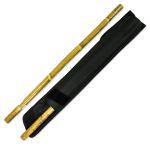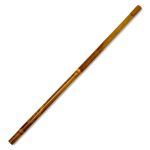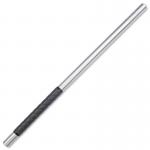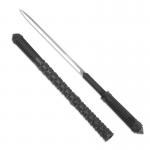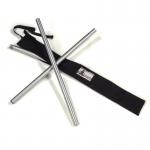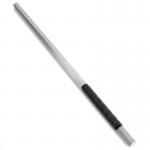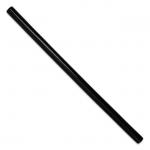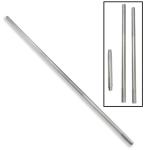What is the Difference Between Escrima Sticks, Kali Sticks, and Arnis Sticks?
May 5th, 2025
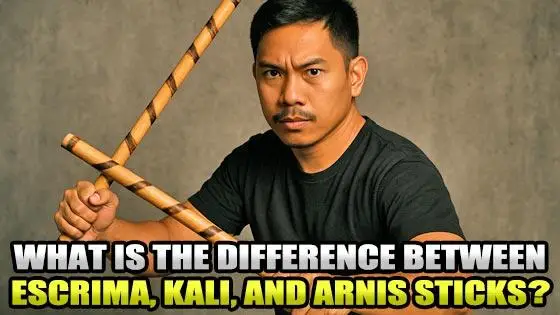
When it comes to Filipino martial arts, escrima sticks, kali sticks, and arnis sticks are essential tools used in training, sparring, and real-world combat. While the terms escrima, kali, and arnis are often used interchangeably, the sticks associated with each martial art also have subtle differences. These differences can be found in the materials, length, and specific techniques that are taught in each system. To fully understand the distinctions, let's explore the characteristics of the sticks used in each of these three prominent Filipino martial arts styles.
The Role of Sticks in Filipino Martial Arts
Before diving into the specific differences, it's important to note that the use of sticks in Filipino martial arts serves several crucial purposes. Sticks are typically used for training and sparring because they offer a balance between safety and realism. Unlike bladed weapons, sticks are less likely to cause permanent harm, making them ideal for practice. The flexibility and precision of stick work also translate well to other weapons like knives and swords. As such, the study of stick fighting in systems like escrima, kali, and arnis lays the groundwork for learning a range of combat techniques, from disarming an opponent to controlling the fight.
While there is considerable overlap in the training of these systems, the sticks themselves differ slightly in terms of length, material, and how they are used within each martial art. Let's break down the specifics.
Kali Sticks: Precision and Versatility
Kali sticks are often regarded as the traditional weapon of choice in Kali, the oldest and broadest of the Filipino martial arts systems. Kali emphasizes a wide range of weaponry and combat techniques, and the stick is typically the starting point for training. Kali sticks are generally lightweight, quick, and extremely versatile, designed for fluid, fast strikes and blocking movements.
Length:
Kali sticks are usually around 28 to 30 inches (71 to 76 cm) in length. This is the most common length for training, though some practitioners may use slightly shorter or longer sticks depending on their training goals or the specific type of Kali they are practicing. A typical Kali stick is designed to be easily wielded with one hand or both hands (when using double sticks) and provides enough reach to control an opponent's weapon or body.
Material:
The most traditional Kali sticks are made from rattan, a lightweight, flexible, and durable material. Rattan sticks absorb shock well, making them ideal for contact training without risk of splintering or breaking easily. However, as Kali evolved and spread globally, other materials such as waxwood, bamboo, and synthetic materials like fiberglass or plastic are sometimes used for increased durability or weather resistance. The flexibility of rattan gives Kali sticks an added advantage, as they can be used for both striking and wrapping around an opponent's weapon or body during a bind.
Purpose and Use:
Kali practitioners focus on flow drills and angles of attack. The use of the stick is highly dynamic, incorporating slashes, thrusts, and circular strikes. The movements are fast, with an emphasis on angle control and the ability to switch between offensive and defensive modes effortlessly. Kali practitioners often train with two sticks at once, learning to use the weapon in both hands to attack, block, and counter an opponent's strikes.
Eskrima Sticks: Tactical and Precise
Eskrima, or Arnis de Mano, is another well-known Filipino martial art that focuses primarily on stick fighting techniques. The term eskrima itself comes from the Spanish word "esgrima," meaning fencing or swordsmanship, and the art developed with a distinct focus on using one or two sticks in tactical, precise combat. Eskrima tends to emphasize distance management and timing rather than the fluidity and versatility seen in Kali.
Length:
Eskrima sticks are typically around 28 inches (71 cm) long, though they can range from 26 inches to 30 inches (66 to 76 cm), depending on the practitioner's preference and the school of Eskrima they follow. These sticks are often slightly thicker than Kali sticks to allow for a better grip during combat. The length is chosen to ensure proper reach and balance when performing both single-stick and double-stick techniques.
Material:
Like Kali sticks, rattan is also commonly used in Eskrima, thanks to its shock-absorbing qualities and durability. However, Eskrima sticks can also be made from waxwood, bamboo, or hardwood, depending on the practitioner's preference for weight and strength. The material choice often impacts the way the stick behaves during training, with waxwood, for example, offering a denser, heavier feel compared to the lighter rattan.
Purpose and Use:
Eskrima is often considered a more tactical form of stick fighting, with an emphasis on precise strikes and defensive maneuvers. Eskrima training frequently involves drills focused on blocking and countering attacks, as well as weapon retention - a critical aspect when facing opponents with either hand-to-hand or bladed weapons. While Kali incorporates more free-flowing techniques, Eskrima tends to be a little more structured in its approach to using the stick in combat. Eskrima also trains practitioners to fight in multiple ranges: long, medium, and close range.
Arnis Sticks: Versatile and Practical
Arnis (also referred to as Arnis de Mano) is another Filipino martial art that shares many similarities with Eskrima and Kali but also has distinct characteristics. Arnis is often practiced as a more sport-oriented system today, but its roots lie in practical self-defense and combat scenarios. The stick used in Arnis is versatile, often bridging the gap between the weaponry-focused combat of Eskrima and the flow-based approach of Kali.
Length:
Arnis sticks are generally of similar length to those used in Kali and Eskrima, ranging from 26 to 30 inches (66 to 76 cm). Arnis sticks are often made to match the body size of the practitioner and are frequently chosen for comfort and control. In some schools, longer sticks may be used, depending on the specific curriculum and techniques being taught. The focus in Arnis is on adaptability and practicality, and the stick is sized accordingly to the individual's stature.
Material:
Traditional Arnis sticks are most commonly made of rattan or waxwood, although modern versions made from aluminum or thermoplastic materials are also available for specific types of training (such as outdoor or heavy-contact sparring). Rattan remains the most popular choice due to its balance of flexibility and strength. The flexibility of rattan also helps Arnis sticks absorb the shock of strikes and prevent injuries during sparring, making them ideal for practitioners at all levels.
Purpose and Use:
Arnis, like Eskrima and Kali, teaches practitioners how to wield sticks for both offensive and defensive purposes. However, Arnis often places a stronger emphasis on self-defense and combat readiness. Arnis training typically involves single-stick techniques and the application of multiple strikes - especially in response to incoming attacks. It's also known for integrating empty-hand techniques with stick work, preparing practitioners to transition from weapon use to hand-to-hand combat in real-world situations.
Key Differences in Sticks and Their Use
While Kali, Eskrima, and Arnis share many similarities in their approach to stick fighting, the subtle differences in their sticks - such as material, length, and training focus - are significant. Kali sticks are often slightly more lightweight and flexible, emphasizing fluidity and adaptability. Eskrima sticks are often thicker and sturdier, reflecting the tactical precision of Eskrima techniques. Arnis sticks, while similar to the other two, offer more versatility and often incorporate a mix of weapon and empty-hand training.
The choice of stick material (typically rattan or waxwood) plays a key role in the feel of the weapon, with rattan being preferred for its shock-absorbing properties and waxwood offering a denser, more durable stick. Aluminum and synthetic materials have also become popular for their durability, especially in outdoor training or heavy-contact sparring.
Conclusion
In the end, the differences between Kali sticks, Eskrima sticks, and Arnis sticks are subtle but meaningful. Each style's stick is designed to suit the principles and tactics taught within that system. Whether you're a beginner or an experienced practitioner, understanding these differences can deepen your appreciation for Filipino martial arts and help you select the right stick for your training.
Before diving into the specific differences, it's important to note that the use of sticks in Filipino martial arts serves several crucial purposes. Sticks are typically used for training and sparring because they offer a balance between safety and realism. Unlike bladed weapons, sticks are less likely to cause permanent harm, making them ideal for practice. The flexibility and precision of stick work also translate well to other weapons like knives and swords. As such, the study of stick fighting in systems like escrima, kali, and arnis lays the groundwork for learning a range of combat techniques, from disarming an opponent to controlling the fight.
While there is considerable overlap in the training of these systems, the sticks themselves differ slightly in terms of length, material, and how they are used within each martial art. Let's break down the specifics.
Kali Sticks: Precision and Versatility
Kali sticks are often regarded as the traditional weapon of choice in Kali, the oldest and broadest of the Filipino martial arts systems. Kali emphasizes a wide range of weaponry and combat techniques, and the stick is typically the starting point for training. Kali sticks are generally lightweight, quick, and extremely versatile, designed for fluid, fast strikes and blocking movements.
Length:
Kali sticks are usually around 28 to 30 inches (71 to 76 cm) in length. This is the most common length for training, though some practitioners may use slightly shorter or longer sticks depending on their training goals or the specific type of Kali they are practicing. A typical Kali stick is designed to be easily wielded with one hand or both hands (when using double sticks) and provides enough reach to control an opponent's weapon or body.
Material:
The most traditional Kali sticks are made from rattan, a lightweight, flexible, and durable material. Rattan sticks absorb shock well, making them ideal for contact training without risk of splintering or breaking easily. However, as Kali evolved and spread globally, other materials such as waxwood, bamboo, and synthetic materials like fiberglass or plastic are sometimes used for increased durability or weather resistance. The flexibility of rattan gives Kali sticks an added advantage, as they can be used for both striking and wrapping around an opponent's weapon or body during a bind.
Purpose and Use:
Kali practitioners focus on flow drills and angles of attack. The use of the stick is highly dynamic, incorporating slashes, thrusts, and circular strikes. The movements are fast, with an emphasis on angle control and the ability to switch between offensive and defensive modes effortlessly. Kali practitioners often train with two sticks at once, learning to use the weapon in both hands to attack, block, and counter an opponent's strikes.
Eskrima Sticks: Tactical and Precise
Eskrima, or Arnis de Mano, is another well-known Filipino martial art that focuses primarily on stick fighting techniques. The term eskrima itself comes from the Spanish word "esgrima," meaning fencing or swordsmanship, and the art developed with a distinct focus on using one or two sticks in tactical, precise combat. Eskrima tends to emphasize distance management and timing rather than the fluidity and versatility seen in Kali.
Length:
Eskrima sticks are typically around 28 inches (71 cm) long, though they can range from 26 inches to 30 inches (66 to 76 cm), depending on the practitioner's preference and the school of Eskrima they follow. These sticks are often slightly thicker than Kali sticks to allow for a better grip during combat. The length is chosen to ensure proper reach and balance when performing both single-stick and double-stick techniques.
Material:
Like Kali sticks, rattan is also commonly used in Eskrima, thanks to its shock-absorbing qualities and durability. However, Eskrima sticks can also be made from waxwood, bamboo, or hardwood, depending on the practitioner's preference for weight and strength. The material choice often impacts the way the stick behaves during training, with waxwood, for example, offering a denser, heavier feel compared to the lighter rattan.
Purpose and Use:
Eskrima is often considered a more tactical form of stick fighting, with an emphasis on precise strikes and defensive maneuvers. Eskrima training frequently involves drills focused on blocking and countering attacks, as well as weapon retention - a critical aspect when facing opponents with either hand-to-hand or bladed weapons. While Kali incorporates more free-flowing techniques, Eskrima tends to be a little more structured in its approach to using the stick in combat. Eskrima also trains practitioners to fight in multiple ranges: long, medium, and close range.
Arnis Sticks: Versatile and Practical
Arnis (also referred to as Arnis de Mano) is another Filipino martial art that shares many similarities with Eskrima and Kali but also has distinct characteristics. Arnis is often practiced as a more sport-oriented system today, but its roots lie in practical self-defense and combat scenarios. The stick used in Arnis is versatile, often bridging the gap between the weaponry-focused combat of Eskrima and the flow-based approach of Kali.
Length:
Arnis sticks are generally of similar length to those used in Kali and Eskrima, ranging from 26 to 30 inches (66 to 76 cm). Arnis sticks are often made to match the body size of the practitioner and are frequently chosen for comfort and control. In some schools, longer sticks may be used, depending on the specific curriculum and techniques being taught. The focus in Arnis is on adaptability and practicality, and the stick is sized accordingly to the individual's stature.
Material:
Traditional Arnis sticks are most commonly made of rattan or waxwood, although modern versions made from aluminum or thermoplastic materials are also available for specific types of training (such as outdoor or heavy-contact sparring). Rattan remains the most popular choice due to its balance of flexibility and strength. The flexibility of rattan also helps Arnis sticks absorb the shock of strikes and prevent injuries during sparring, making them ideal for practitioners at all levels.
Purpose and Use:
Arnis, like Eskrima and Kali, teaches practitioners how to wield sticks for both offensive and defensive purposes. However, Arnis often places a stronger emphasis on self-defense and combat readiness. Arnis training typically involves single-stick techniques and the application of multiple strikes - especially in response to incoming attacks. It's also known for integrating empty-hand techniques with stick work, preparing practitioners to transition from weapon use to hand-to-hand combat in real-world situations.
Key Differences in Sticks and Their Use
While Kali, Eskrima, and Arnis share many similarities in their approach to stick fighting, the subtle differences in their sticks - such as material, length, and training focus - are significant. Kali sticks are often slightly more lightweight and flexible, emphasizing fluidity and adaptability. Eskrima sticks are often thicker and sturdier, reflecting the tactical precision of Eskrima techniques. Arnis sticks, while similar to the other two, offer more versatility and often incorporate a mix of weapon and empty-hand training.
The choice of stick material (typically rattan or waxwood) plays a key role in the feel of the weapon, with rattan being preferred for its shock-absorbing properties and waxwood offering a denser, more durable stick. Aluminum and synthetic materials have also become popular for their durability, especially in outdoor training or heavy-contact sparring.
Conclusion
In the end, the differences between Kali sticks, Eskrima sticks, and Arnis sticks are subtle but meaningful. Each style's stick is designed to suit the principles and tactics taught within that system. Whether you're a beginner or an experienced practitioner, understanding these differences can deepen your appreciation for Filipino martial arts and help you select the right stick for your training.
You May Also Be Interested In:
Leave a Reply






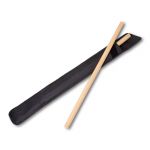
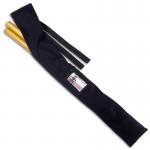
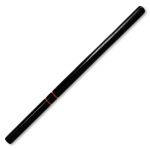
 (1)
(1)
